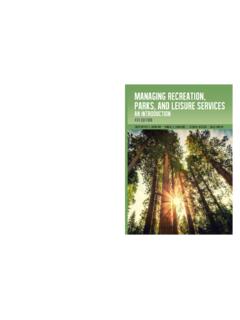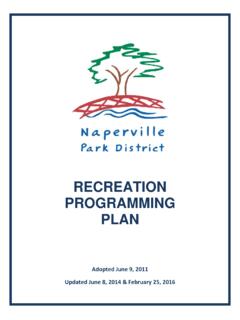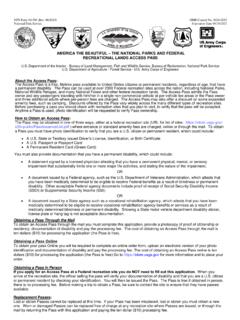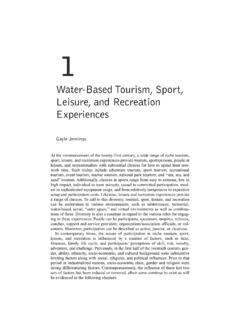Transcription of Willamette River - Oregon
1 Willamette RiverRecReationGuideFRONT AND BACK COveR phOTOS: Wallace Marine park , Salem, OregonleFT: Sunset over Willamette River near SalemBob PooltThe Willamette River is a vital thread that weaves together the tapestry of the Willamette Valley and the 19 cities it flows through. The Willamette provides impor-tant irrigation for the agricultural industry while supporting a variety of recreational opportunities from boating and water skiing to fishing and nature viewing. You can expect to see something different around every bend of the River , from an osprey swooping in for lunch to a grace-ful blue heron surveying the scenery; a deer on the shoreline lapping up a drink of water to a beaver swimming along the shore. The Willamette is also home to a variety of fish including sturgeon, cut-throat trout and so visible is the importance of this beautiful River in our state s history.
2 Early mills, ferries and numer-ous towns clung to the River for power and trans-portation. For centuries before the settlers arrived, Native Americans relied on the River s bounty as invite you to use this Willamette River Recreation Guide to discover this great resource and to connect with the richness it has to sMESSAGEiiiSECTION VSECTION IVp 30p 27p 26 NEWBERGWEST LINNLAKEOSWEGOEUGENECOTTAGEGROVECORVALLI SALBANYSALEMGLADSTONEOREGON CITYMILWAUKIEPORTLANDSCAPPOOSEW i l l a m e t t e R i v eR m a p pa g e guideSECTION IIISECTION IISECTION Ip 29p 25p 23p 22p 21p 19p 18p 17p 15p 14p 13introduction 1 History of the Willamette 2-3plant and animal life 4-5 Willamette -area wildlife refuges 5 Keeping Our River Clean 6-7 Boating on the Willamette 8-9 River characteristics and hazards Navigation aids excursions and Outings 10-11 River mileage and float timespopular destinations 12-13 Suggested fishing areas Guide to Oregon State Parks Festivals and events River guide and maps
3 14-32 i middle and Coast Forks 14-17 ii Springfield to albany 18-21 iii albany to St. paul/Newberg 22-25 iv Newberg to portland 26-29 v multnomah Channel 30-32 Resources 34index 35 Photo CrEditSOregon State Marine Board (OSMB) Oregon Parks and Recreation Department (OPRD)Willametter Riverkeeper (WR) Oregon Historical Society (OHS)Front and back cover photos: Larry AndreasenContentsto learn more about boating in Oregon go to: detailed information on state parks in Oregon go to: 20071 Introductiont1 PubliC uSES And rECrEAtionAl oPPortunitiESA great many pastimes can be enjoyed on the Willamette . These in clude boating, camp ing, picnicking, swim ming, hiking, bicycling, wildlife viewing, fishing, and hunting. There are ten state parks, three public ferries, and more than 170 Oregon State Willamette River Green way parcels, city and county parks, boat ramps, and Division of State Lands parcels along the River and its major tributaries.
4 The River provides habitat for hundreds of types of plants and many species of birds, fish, and vASt River SyStEMThe Willamette River drains 12,000 square miles of land at an average rate of flow that would fill 175 buildings the size of Portland s tallest skyscraper every day. About thE WillAMEttEThe Willamette is a vital, multi-purpose waterway that touches the lives of millions of people. It provides ports for commercial barges and oceangoing ships, irrigation for crops sold worldwide, an abundant fishery, and recreational 70 percent of Oregonians live within 20 miles of the Willamette River , and some may not even realize it. Although the River passes through nine counties and 19 cities, miles of its channels and backwaters cannot be seen from roads or towns. With many communities no longer economically dependent on it, the Willamette can be overlooked so familiar a part of our landscape that it fades into the you re a veteran or a rookie on the Willamette , it is important to respect its waters.
5 Although considerably tamer than the way explorers found it 200 years ago, the Willamette still changes with each season and even with the daily tides. Never dis-regard its power or dismiss its to uSE thE GuidEThis guide is designed to make it easy to visit and safely experience the River , whether by boat, bicycle, motor vehicle or on foot. It begins with the Willamette s history, remembering the River s role in early settlement through modern times. With illustra-tions of diverse species, the wildlife section celebrates the abundance and beauty of the River s plants and animals. Next, the clean River section outlines sanitation concerns, waste issues and innovative programs like Clean Marina. The boating section offers safety tips and information about the rules and hazards of navigation. Finally, the guide highlights suggestions for planning a trip and the destinations which are best suited for boating, biking, hiking, fishing, or remainder of the guide provides detailed maps for each section of the Willamette .
6 They include: state and local parks, state greenway and Division of State Land parcels, boat ramps, marinas, wildlife areas, public roads that lead to parcels or parks, and other points of interest. Finally, there is a list of contact information for additional resources. We hope this publication informs you and encourages you to enjoy the many facets of the : Canoeing on the WillametteBelOW: Wakeboarding on the WillametteosmBosmBThe Willamette River begins its nearly 300-mile journey in the high Cascades southeast of Eugene. Winding through forest, farmland and city, it travels northward the length of the Willamette Valley before joining the Columbia River at Portland. Along the way, it changes from a rushing mountain stream into a substantial River more than a quarter-mile Oregonians, the Beautiful Willamette is more than just a lovely River . It is a key part of our col-orful history, a vital economic resource, and a place to recreate or relax to enjoy the many virtues Oregon has to Willamette is one of the few major rivers in the that flows primarily north.
7 So narrow and shallow in places that pioneers felled trees for bridges, it also widens to more than 2,000 feet across in Portland. Originally, the River meandered in a wide swath across the valley floor, changing chan-nels frequently to form new islands and oxbows. Today, the Willamette is rather tame by comparison. Wing dams, revetments, dredging and flood control projects have altered the flow patterns to create a simpler, deeper AMEriCAnSThere is evidence of human presence in the Willamette Valley as long as 10,000 years ago, several thousand years after the close of the Ice Age, when Asiatics from what is now Siberia crossed over an Alaskan land bridge into North of the Willamette Valley Native American inhabitants were Kalapuyans a collection of bands that shared the same dialect. They included the Calapooia, Tualatin, Santiam, Yamhill, and Luckiamute bands.
8 Although these native bands in the valley subsisted mostly on nuts, berries and roots, they also were good hunters using the snare and trap as effectively as the bow and smallpox epidemic in 1782-83, followed by a malaria epidemic from 1830-33, wiped out 80 percent of the native people. By 1856, surviving members of the various bands were resettled under treaty onto the Grand Ronde reservation near Valley SEttlEMEntThe Willamette River was first noted in 1792 by English navigator Lt. William R. Broughton, a member of Capt. George Vancouver s expedition. Then in 1806, explorers Lewis and Clark ventured upriver for about seven miles on behalf of the United States. The first Euro-Americans were the fur trappers, mostly working for the Hudson s Bay Company at Ft. Vancouver. They were followed by the mission-aries, who tried mightily to convert Native Americans to Christianity.
9 Finally, there came the settlers, mostly farmers, who crossed the Oregon Trail. 53,000 of them reached the valleys of Oregon between 1840 and burninGA common Native American practice was to burn preserves in the Willamette Valley each fall. This created and main tain ed the oak and grass land savanna that favored elk and deer as well as camas, tar weed, and acorn habitat important foods for the native population. The cleared land helped in the gather ing of seeds, roots, and bulbs, as well as creat ing exposed areas for easier hunting. The brush burning also created major areas of open prairie that attracted Euro-American settlers because the land was already WillametteFrom the Cascades frozen gorges,Leaping like a child at play,Winding, widening through the valley,Bright Willamette glides away; Onward ever, Lovely River ,Softly calling to the , that scars us,Maims and mars us, Leaves no track or trench on thee.
10 Samuel L. Simpson, 1868 EArly trAdErSThe first large vessel to enter the Willamette was the Owyhee, a Boston trading ship that sailed to within a mile of Willamette Falls in 1829 the same year Hudson s Bay Com-pany established an outpost at Oregon millPerhaps for as long as 10,000 years, the Willamette River basin has been the wellspring of life for the people who have lived along its shores and ridden its waters. It has been a major source of food, water, transportation and commerce in the bountiful heartland of western Oregon the Willamette thE Oregon -built StEAMErOn Christmas Day 1850, the 160-foot steamboat Lot Whitcomb, left, was launched at the Milwaukie basin. The first steamboat built in Oregon , its side wheels measured 18 feet in diameter. By 1878, some 52 side wheel and sternwheel steam ers had been built along the Willamette , most of them at Canemah just above Willamette Falls.
















